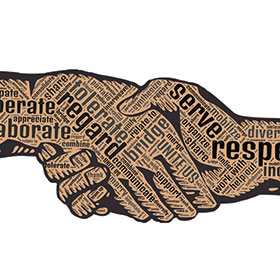

I’ve repeatedly heard the comment, ‘We need more cameras’ when people are faced with higher crime rates. This is often a legitimate comment where people need to broaden the coverage of their systems, either to deal with opportunistic or syndicate-based theft. There are a wide range of factors that influence whether crime takes place. These are explored in issues such as the crime triangle, methods of reduction of crime, and things like environmental design that I cover in my training.
However, I want to focus on three major factors that come to my mind when looking at the reduction of antisocial or crime related events that I have experienced when travelling internationally. These are:
• Value systems and normative behaviour.
• Community involvement.
• Physical display of the presence of enforcement.
Just one of these factors will be enough to reduce the chance of something happening, but in the presence of a combination of all of them, an incident is extremely unlikely to occur. Equally, if all of these are lacking, then the change of incidents including those of an extreme nature increase substantially.
If the value systems are strong in defining accepted behaviour and people subscribe to these values, violations are far less likely to occur. These values define what is important to the common good, and are encouraged by leadership, family and society, history, and a sense of moving forward.
In some cases they become common nature to citizens who follow them without even thinking about them. While there may always be exceptions of the rule, the vast majority of people voluntarily adhere to these kinds of expectations. The defined values may only affect particular areas of life, especially those that are seen as particularly important for the sake of general harmony of society. They can also be temporary, lasting only for the duration of a transitional situation. However, where these are communicated clearly, they can often take effect relatively quickly.
Normal social values
A trip I took to Japan recently highlighted a number of aspects of an ordered society, but one of the most striking was in two weeks of travelling, I saw only eight pieces of litter. This is not due to large numbers of litterbins, which are in fact in short supply, but the Japanese have a culture where it is seen to be irresponsible and disrespectful to litter.
At one railway station, a woman eating her ice-cream dropped some of it on the platform floor. She reached into her bag, took out a tissue, mopped up the ice cream on the floor then put the dirty tissue back into her bag as there wasn’t a litterbin available. The conscientiousness in following accepted values is extremely strong.
This is not to say there is no crime in Japan and the Japanese mafia (the Yakuza or gokud) are famous, but there are certain values that are adhered to as part of their communal living. Similarly, they line up on each side of the entrances when a train arrives, let everybody out, then move in in an ordered fashion.
On separate trips to the UK over the last two years amounting to two weeks of driving around, I didn’t see any traffic violations besides what could be seen as slightly fast driving on the freeway. Again, it doesn’t mean that there are no traffic violations or drunk drivers, but they are rare and not tolerated. These value systems provide a moral compass for people within the society, provide direction, and reinforce behaviours that are constructive for society. Within the areas they address, they also reduce the likelihood of crime and criminals
Take action and get involved
The area of community involvement refers to members of the community taking action to address violations or infringements. This may be as simple as somebody telling a would be shoplifter to ‘come off it’ as a delegate on one of my courses in the UK recently said to a suspect. Even the act of moving closer to a situation which seems to be an issue could reflect this approach, for example moving closer to an argument between two people to ensure that violence was unlikely to be used and to show they are being observed.
It could involve calling for security or police to address a suspect situation or person, or even providing information relating to possible crimes. More recently in South Africa, we saw large protests by people, and mobilisation of a range of groups and institutions to campaign against corruption that led to the removal of a sitting president.
In its most minor form, it may consist of individuals nudging others to do ‘the right thing’. It may lead to interventions at an individual or group level as part of constructive involvement to pre-empt or deal with situations. In its most radical form it consists of community group violence against perceived perpetrators, often reflecting a failure of other methods to address community concerns.
This kind of community involvement needs to be supported by a culture of involvement and ultimately a sense of responsibility and accountability. If you have whistle-blowers to corruption being hounded or fired, it does little to combat widespread corruption or the failure of integrity in our systems and people.
Physical presence denotes security
The physical display of presence by security or police is designed to warn anybody of the implications of possible infringement, and to indicate that they will be caught if they try anything. Unlike cameras, there is an implication in that officials are in a position to react immediately to a crime and are in place. The objective of this presence is show people a psychological and physical sense of support, not to intimidate and the credibility of the policy or security is critical in this respect.
The Miami South Beach area is one of the major drawcards for tourism in Florida, and the presence of police vehicles is everywhere. Many of these don’t even have police in them, they are just parked on the side of the road. However, the fact that they are there creates an environment where people feel protected and criminals don’t want to take the chance of being caught.
Combined with police moving around, stopping and talking to people, and being on foot or Segways creates a situation where you feel quite comfortable walking through the South Beach streets at 11:30 at night and the movement of people creates a thriving business environment. This despite the fact that the main city of Miami just a few kilometres away has more of a reputation for crime.
The high presence of police on Gautrain is a local example where the regular presence and movement creates a safer environment. The presence of armed police in European airports is a similar issue. Of course, the disadvantage of this approach is that it is manpower intensive and is a lot more costly than normal. It is also difficult to cover a large area on this basis, so it tends to be a method that is focused on particular target areas that are seen as high priority or part of critical infrastructure.
The examples used during the discussion of value systems, community involvement, and physical display of security all show a high impact of the approach in preventing crime. As discussed, combining them has an even greater impact on the areas they affect. There are, however, limits to how well they work socially, geographically, and in some cases, over time.
All the areas illustrated in this article also have cameras positioned in them, to provide the capacity to follow up when violations do occur. I’ve commented in a previous article about how important an effective and timeous capacity to respond to incidents is. But the point I’m making in this article is that if the likelihood of any incident happening is reduced significantly, the need for cameras and response is also reduced significantly.
These kinds of strategies can work at national, industrial, city, factory, and personal environments, but they need commitment from leadership, communities, law enforcement, and members of society. They are also currently in crises in South Africa with the last eight years having devastated common value systems and common identity. If you think of where there is an absence of upstanding value systems, community involvement, and physical display of security presence, it explains much of the difficulty experienced with the South African crime environment, as well as some others around the world.

It is possible to build and develop these positive concepts, though, no matter how battered they may appear to be, and this should be a priority for leaders and members of all communities.
Dr Craig Donald is a human factors specialist in security and CCTV. He is a director of Leaderware which provides instruments for the selection of CCTV operators, X-ray screeners and other security personnel in major operations around the world. He also runs CCTV Surveillance Skills and Body Language, and Advanced Surveillance Body Language courses for CCTV operators, supervisors and managers internationally, and consults on CCTV management. He can be contacted on +27 (0)11 787 7811 or [email protected]
| Tel: | +27 11 787 7811 |
| Email: | [email protected] |
| www: | www.leaderware.com |
| Articles: | More information and articles about Leaderware |

© Technews Publishing (Pty) Ltd. | All Rights Reserved.